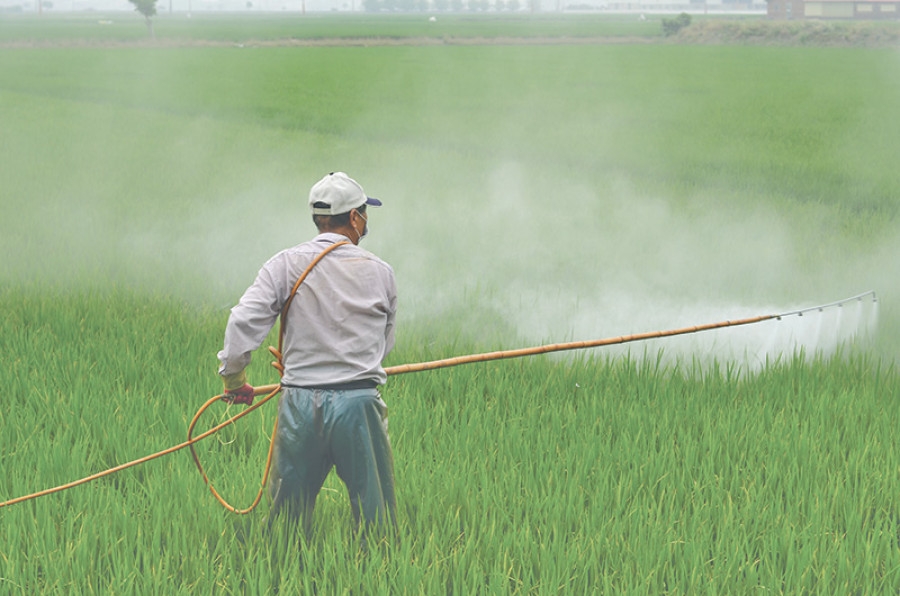Opinion
Subtle venom
Pesticide poisioning continues to pose dangers to the agricultural industry
Dharmendra Kalauni
According to a 2018 World Bank estimate, agriculture comprises around 9.5 percent of the Gross Domestic Product (GDP) for all developing countries. In Nepal, agriculture contributes to about one-third of the GDP. Commercial agriculture is the only way forward for achieving prominent development in agriculture and to meet the current demand for food. The ‘Agriculture Development Strategy (ADS)’ is the most ambitious long-term strategy that aims to make Nepal self-sufficient in the next few years through agri-modernisation and commercialisation. However, in a bid to increase production, agricultural crops are treated haphazardly with abundantly available pesticides. This unsystematic treatment of crops poses a great danger: pesticide poisoning. The rampant use of chemical pesticides has been leaving an excessive amount of pesticide residue in the agro-commodity—often exceeding the maximum residue level (MRL).
Chemical pesticides were first introduced in Nepal in 1955 but the government started importing pesticides from 1956. Paris green, Gamaxone, and Nicotine sulphates were first imported pesticides from the United States of America for malaria control. Later in the early-sixties, pesticides were introduced in Nepal for the agricultural sector to control agro-diseases and pests. Initially, the use of pesticide in the agricultural sector was limited but the green revolution ushered in practices that taught farmers to use agrochemicals especially fertilisers, intesecticides, and fungicides. Now, the use of such pesticides in the agricultural sector has become indispensable. In 2016, Nepal imported a total of 1,640,317.85 kgs of pesticides—worth around Rs. 70 million.
Pesticides are mainly used for controlling insects and diseases, increasing yield and increasing the shelf life of the agri-commodity. It is used in the form of insecticides, fungicides, herbicides, bactericides, acaricides, rodenticides, andmolluscicides among others. A common and growing misconception among farmers is that pesticides offer a quick, efficient and cheap method to get rid of pests and to prevent plant diseases—which has consequently led to a currently booming pesticide business in the country.
Studies have shown that intensive uses of pesticide—above the national average consumption value— is vividly seen in the highway corridors, Terai region and other areas with easy accessibility of infrastructures like roads. A comparative study on the consumption of pesticides in different ecological region of Nepal shows that the highest average in pesticide consumption was in Terai followed by Kathmandu hill, and high hill regions. Studies on the status of pesticide residue among the development region showed that the Central Development Region held the highest amounts of pesticide consumption. This means major cities like Kathmandu, Chitwan, Lalitpur, Bhaktapur, Dhading, Kavre are prone to emerging risks of health hazards and environmental pollution from excessive use of pesticides and resulting residue problem.
Another common factor in areas of high pesticide usage was that they also invested heavily in intensive commercial farming of vegetables, tea, and cotton. The national survey on pesticide consumption statistics in Nepal reported that pesticide application is higher in vegetables, followed by cash crops, cereals and fruits. Aryal et.al (2013) reported that the frequency of application of pesticides in popular vegetable products like potato, tomatoes, cauliflowers, cabbage, beans, tomato, ladyfinger, bitter gourd, pumpkin, cucumber and bottle gourd is as higher as about five applications per cropping season. Among different cultivated vegetables, eggplant had the highest pesticide usage followed by tomato crops. Similarly, cotton, potato , and cole crop are other agricultural commodity that are subjected to application of pesticide in relatively greater amount. Vegetables like carrots, cucumbers, brinjals, okra, cowpeas, green beans, tomatoes, chilli, cauliflower, bitter guard, bottle guard, potato and pumpkin are subjected to major threats for pesticide residue—resulting from the non-judicious application of chemical pesticides. The highest concentration of cypermethrin is found in tomatoes and brinjals, the concentration of Deltamethrin is highest in cowpea followed by cauliflower, tomato and brinjal. The concentration of Carbendazim and Mancozeb is also the highest in tomato followed by bottle guard and chilli.
To curb the situation, the government has banned sixteen highly toxic and potentially residue-producing pesticides like Aldrin, Benzene hexachloride, Chlordane, DDT, Dieldrin, Endosulfan, Endrin, Heptachlor, Lindane, Methyl parathion, Mirex, Monocrotophos, Organo mercurial Fungicides, Phorate, Phosphamidon and Toxafen for marketing across the country. But such measures alone will not suffice—they must be supplemented by concrete actions from the state. The government should make a sound monitoring body to curb the illegal trade of banned pesticides, especially in areas near the open border. Agricultural commodities must be checked for the residue level in them for consumer’s safety in the major vegetable collection centers of the country. Organic agriculture can be promoted by government by providing enough incentives. When it comes to pest management, safe and sustainable practices like integrated pest management should be adopted by farmers and use of bio-pesticides, botanicals and herbal products must be encouraged among farmer’s community. The consumers, on their part, need to make sure the vegetables they consume do not possess residues above the maximum residue level. Simple acts like thoroughly washing the groceries with high speed tap water or salt water before consumption can help reduce the pesticide residue present in vegetables, fruits and legumes.
Kalauni is an agriculture student at the Agriculture and Forestry University, Chitwan.




 15.12°C Kathmandu
15.12°C Kathmandu










